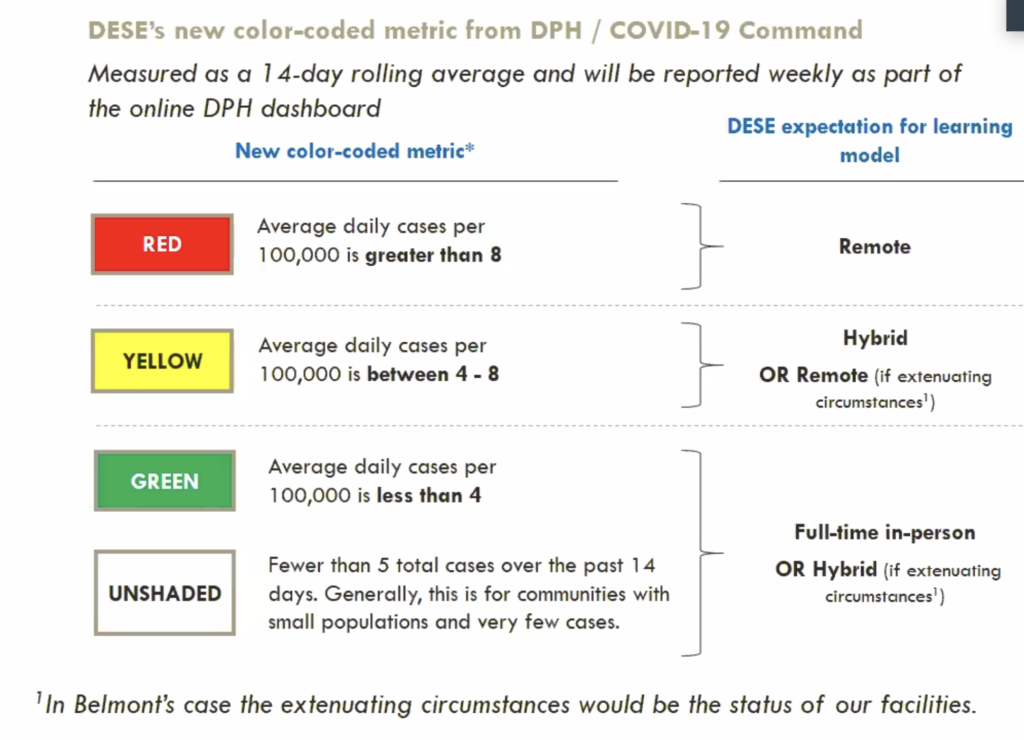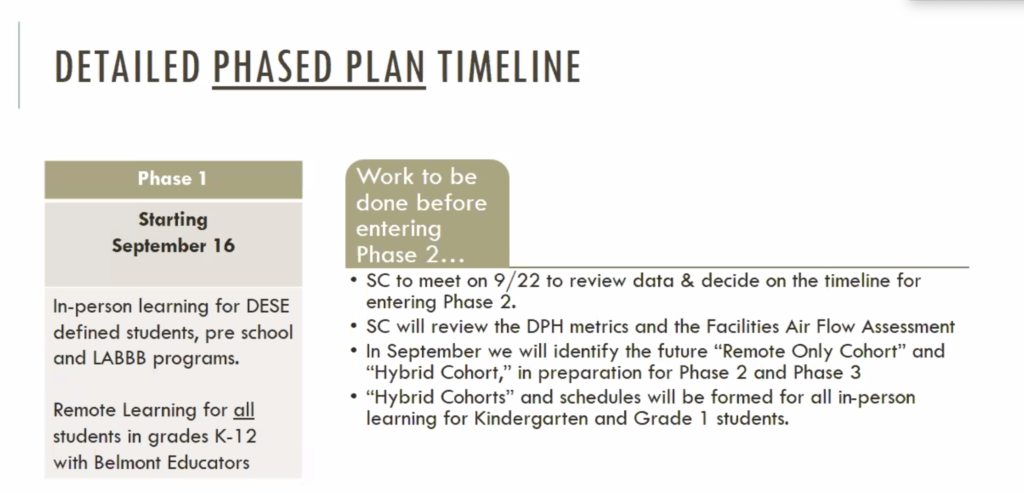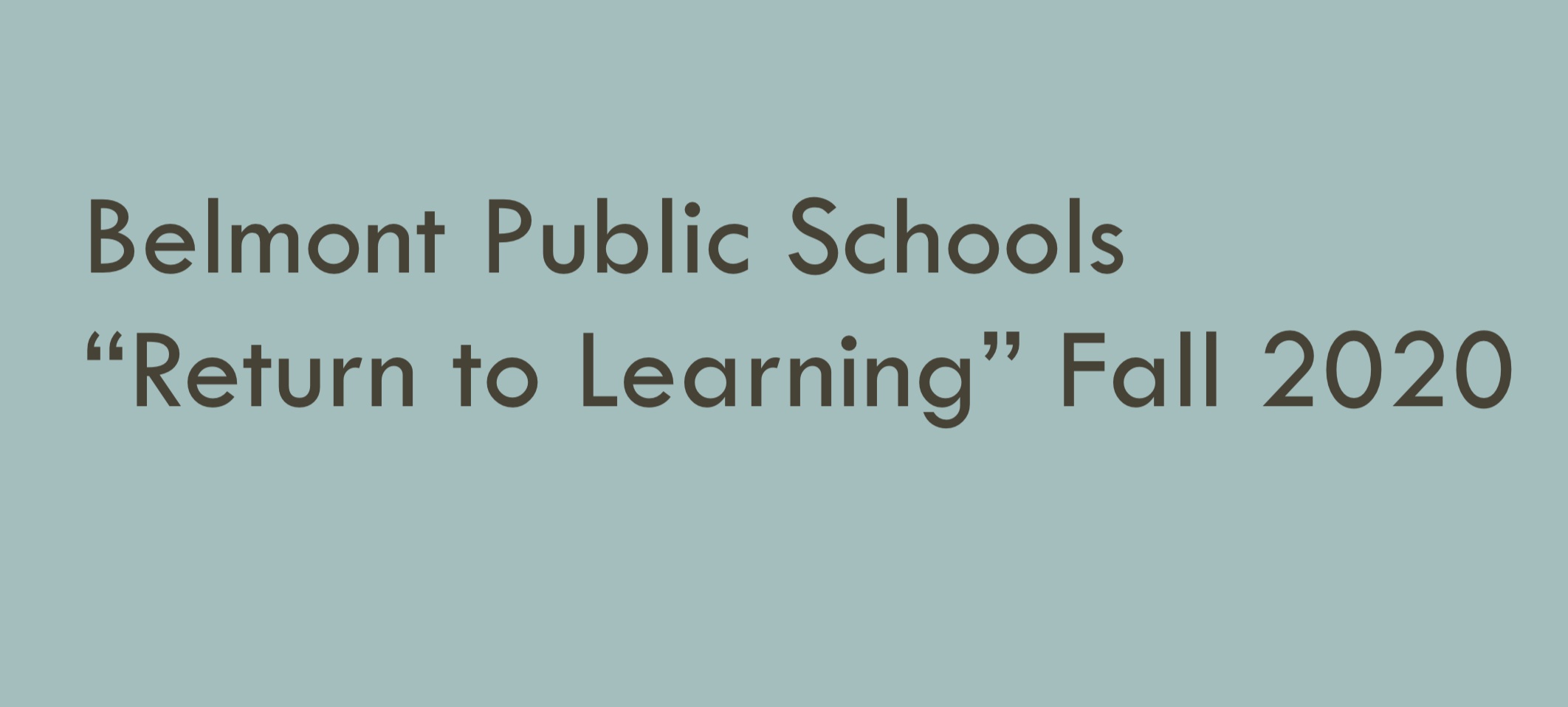Photo: The title page of the Belmont School District’s presentation on the coming school year
After questions from parents and students on how and when Belmont schools would transition between the four learning phases established last week, the Belmont School District released a detailed blueprint on the health and safety criteria the community and each school building will need to meet to move from remote to hybrid and finally in-class learning.
In addition, the district produced the “earliest” date these changeovers can take place, which could occur as quickly as three weeks after entering each initial phase.
“The hope is that we have some clear understanding of what this presentation means for families and students so they can plan their lives and in their work as well,” said John Phelan, superintendent of Belmont schools last week before the School Committee. The district will start learning remotely on Sept. 16
The creation of the multi-stage approach was necessitated by the continued COVID-19 pandemic that is likely to stay active for the entire 2020-21 school year.
According to Phelan, the earliest possible dates that each transition could occur are:
- Beginning of the school year in Phase 1: Sept. 16
- The transition from Phase 1 to Phase 2 (Remote 2): Oct. 19
- The transition from Phase 2 to Phase 3 (Hybrid): Nov. 9
- The transition from Phase 3 to Phase 4 (In-person): TBD by state Department of Elementary and Secondary Education.
Phelan noted the dates provided are “best case” estimates involving a “three-week decision-making cycle.”
The district and the town’s Health Department will work closely in determining when the transitions can occur using a dual system of health measures, one issued by the state and the second a comprehensive test of air circulation in Belmont school buildings.
The first is one devised by DESE which uses a color-coded system – red, yellow, green and unshaded – that measures weekly the 14-day rolling average of daily cases of COVID-19 in each community.

If the average daily cases are less than eight or fewer (green and yellow), Belmont schools will be allowed to move to the next phase. Greater than eight will require the town to move to a remote system.
The latest data from the state puts Belmont in the green sector with 1.7 cases.
But before Belmont students prepare to move onward to “Remote 2” the town’s schools are undergoing a thorough examination of their facilities air exchange systems to determine if the machinery is working up to the manufactures standards and if they move the air at a sufficient rate to create a flow that will disrupt the concentration of coronavirus droplets in the air.
Phelan said that work, known as the Facilities Air Flow Assessment, will be completed around the time school begins and a report will be produced two weeks later in late September.
“That is why we will pause right now and not jump right into hybrid because we just don’t know that information yet and moving into a scenario without all the information,” said Phelan.
In anticipation that some areas and rooms will need to have an alternative , the district has purchased 100 filtration systems to add to the circulation of air in each room.
Only if the two safety measures are met will the district come before the school committee for discussion and a vote to move to the next phase.
The district has also committed to working towards the next phase as they prepare for the expected transition.
While the schools are in Phase 1, district officials will be reviewing data and decide on a timeline for entering Phase 2 and the air exchange assessment will be reviewed as well as the DESE metrics.

It will be during this time that parents and guardians will receive a notice of whether their children will wish to enter the hybrid phase and those who will stay in a remote-only cohort. Finally, schedules will be created for those kindergarteners and first graders which will enter the hybrid in-person learning under Phase 2.
For more information on the transition of phases and the work being that the district will conduct during each phase to prepare to move between stages, a link to the district’s charts can be found here.
Discussion among the School Committee members ranged from concerns on understanding on the extent of the interior assessments – some schools (the nearly decade-old Wellington) are in better shape than others. So far, the district has paid $25,000 in labor and parts to prepare the schools, $15,000 will go to repairing all screens and window repairs, $42,000 on HVAC updated and $100,000 to purchase 100 air purifying units.
The School Committee’s Tara Donner, who is also a teacher in Winchester, voice an issue with the focus on “plowing ahead as fast as possible” into the hybrid phase when there hasn’t been much discussion on effectively staffing that step. Speaking from her own experience, Donner said “these models are frankly fairly incompatible to good teaching” until the district has a quality educational model in mind.
“I want to make sure we’re not putting the cart before the horse,” he added.








Leave a Review or Comment